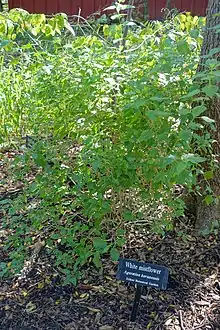Ageratina havanensis
Ageratina havanensis, the Havana snakeroot[3] or white mistflower,[4] is a species of flowering shrub in the sunflower family, native to Texas, Cuba, and northeastern and east-central Mexico (Veracruz, Tamaulipas, Coahuila, Nuevo León, Hidalgo, San Luis Potosí, Puebla, Guanajuato, Querétaro).[5] Unlike many other species of Ageratina, it is evergreen.[6][7][8][9]
| Ageratina havanensis | |
|---|---|
 | |
| Scientific classification | |
| Kingdom: | Plantae |
| Clade: | Tracheophytes |
| Clade: | Angiosperms |
| Clade: | Eudicots |
| Clade: | Asterids |
| Order: | Asterales |
| Family: | Asteraceae |
| Genus: | Ageratina |
| Species: | A. havanensis |
| Binomial name | |
| Ageratina havanensis (Kunth) R.M King & H.Rob. | |
| Synonyms[2] | |
|
Synonymy
| |
Etymology
Ageratina is derived from Greek meaning 'un-aging', in reference to the flowers keeping their color for a long time. This name was used by Dioscorides for a number of different plants.[10]
References
- Botanic Gardens Conservation International (BGCI) & IUCN SSC Global Tree Specialist Group (2019). "Ageratina havanensis". The IUCN Red List of Threatened Species. IUCN. 208. e.T144308616A149008129. doi:10.2305/IUCN.UK.2019-2.RLTS.T144308616A149008129.en.
- "Ageratina havanensis (Kunth) R.M King & H.Rob.". The Global Compositae Checklist (GCC) – via The Plant List.
- "Ageratina havanensis". Natural Resources Conservation Service PLANTS Database. USDA.
- Williamson County Chapter (NPSOT-Wilco) Native Plant Society of Texas, Ageratina havanensis – White Mistflower
- George Diggs; Barney Lipscomb; Robert O'Kennon (1999). Shinners & Mahler's Illustrated Flora of North Central Texas. ISBN 978-1-889878-01-0.
- Nesom, Guy L. (2006). "Ageratina havanensis". In Flora of North America Editorial Committee (ed.). Flora of North America North of Mexico (FNA). 21. New York and Oxford – via eFloras.org, Missouri Botanical Garden, St. Louis, MO & Harvard University Herbaria, Cambridge, MA.
- "Ageratina havanensis". County-level distribution map from the North American Plant Atlas (NAPA). Biota of North America Program (BONAP). 2014.
- Turner, B. L. 1997. The Comps of Mexico: A systematic account of the family Asteraceae, vol. 1 -- Eupatorieae. Phytologia Memoirs 11: i–iv, 1–272
- Turner, B. L. 2010. Phytologia 92:388-399
- Gledhill, David (2008). "The Names of Plants". Cambridge University Press. ISBN 9780521866453 (hardback), ISBN 9780521685535 (paperback). pp 39
This article is issued from Wikipedia. The text is licensed under Creative Commons - Attribution - Sharealike. Additional terms may apply for the media files.
